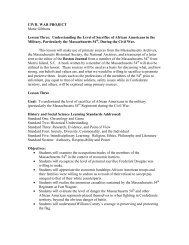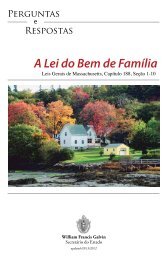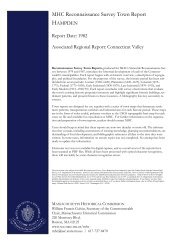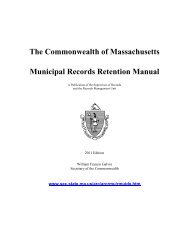Roads, Rails, and Trails - Secretary of the Commonwealth
Roads, Rails, and Trails - Secretary of the Commonwealth
Roads, Rails, and Trails - Secretary of the Commonwealth
Create successful ePaper yourself
Turn your PDF publications into a flip-book with our unique Google optimized e-Paper software.
THE SAMPSON’S TAVERN SITE, LAKEVILLE<br />
The area where Massachusetts Routes 18 <strong>and</strong><br />
105 meet in Lakeville is among <strong>the</strong> most scenic places in <strong>the</strong><br />
<strong>Commonwealth</strong>. Our largest natural lake—Assawompsett<br />
Pond—is here, as are three o<strong>the</strong>r large ponds: Long Pond,<br />
Pocksha Pond, <strong>and</strong> Great Quittacas Pond. These <strong>of</strong>fer acres <strong>of</strong><br />
open water. Since Assawompsett Pond is also a municipal<br />
water supply; its protected shoreline is surrounded by<br />
unspoiled marshes <strong>and</strong> forests. The area also has fields <strong>and</strong><br />
farms, <strong>and</strong> is a favorite with anglers, birdwatchers, <strong>and</strong><br />
sightseers <strong>of</strong> all kinds.<br />
Lakeville, Massachusetts<br />
At <strong>the</strong> northwest corner <strong>of</strong> Assawompsett Pond <strong>the</strong> two<br />
roads meet <strong>and</strong> travel as one along <strong>the</strong> pond’s scenic shore<br />
before dividing again. For many years <strong>the</strong>re was a tavern<br />
here—known as Sampson’s Tavern—which catered to <strong>the</strong><br />
region's visitors. By <strong>the</strong> late twentieth century <strong>the</strong>re was only<br />
dense brush <strong>and</strong> woods alongside <strong>the</strong> road. But since portions<br />
43<br />
<strong>of</strong> <strong>the</strong> roads were not safe, <strong>the</strong> Massachusetts Department <strong>of</strong><br />
Transportation planned a realignment project. They needed an<br />
archaeological study to find out whe<strong>the</strong>r traces <strong>of</strong> <strong>the</strong> old<br />
tavern remained in areas that would be needed for <strong>the</strong> new<br />
roadway. From 1992 to 1994 archaeologists from University <strong>of</strong><br />
Massachusetts Archaeological Services studied <strong>the</strong> history <strong>and</strong><br />
archaeology <strong>of</strong> what became known as <strong>the</strong> Sampson’s Tavern<br />
site, documenting nearly two centuries <strong>of</strong> changing ownership,<br />
activities, buildings, <strong>and</strong> l<strong>and</strong>scapes here.<br />
In <strong>the</strong> 1890s Sampson’s Tavern was an impressive building<br />
that could seat up to 100 customers.<br />
It wasn’t just <strong>the</strong> scenic lakes that made this spot<br />
suitable for a tavern; it was <strong>the</strong> roads. The road that ran past <strong>the</strong><br />
tavern was a main route between Boston <strong>and</strong> New Bedford,<br />
ensuring a steady supply <strong>of</strong> hungry <strong>and</strong> thirsty travelers. A<br />
tavern was in operation here by <strong>the</strong> mid 1700s; it was named








